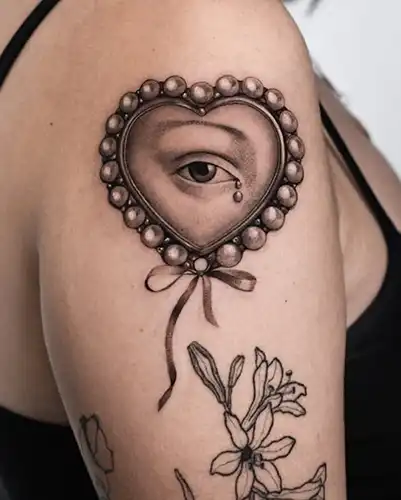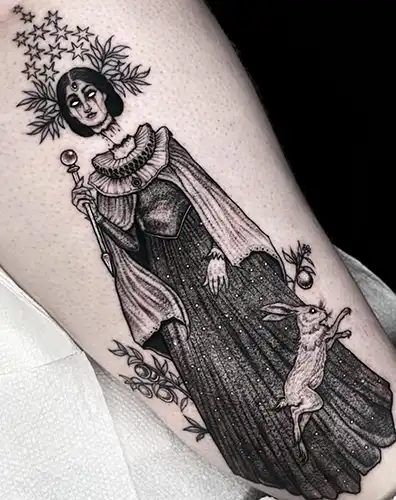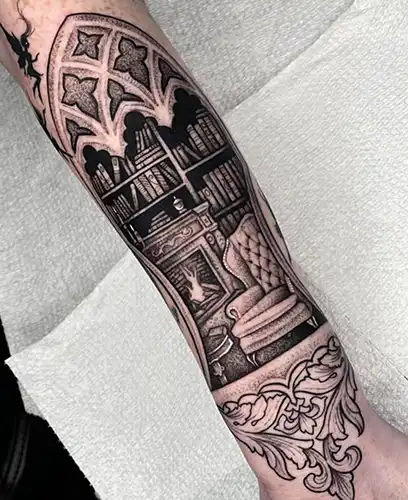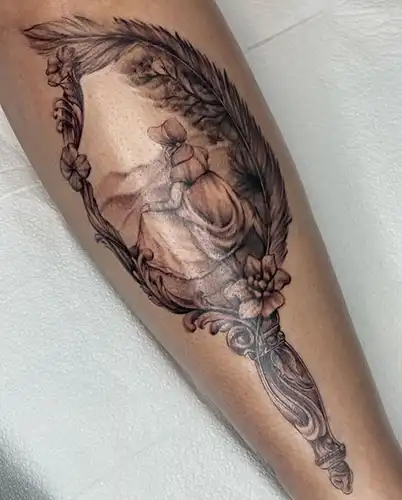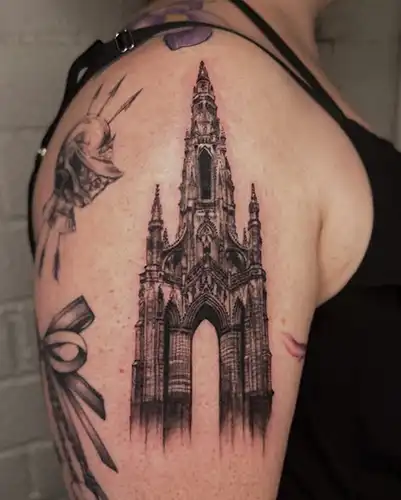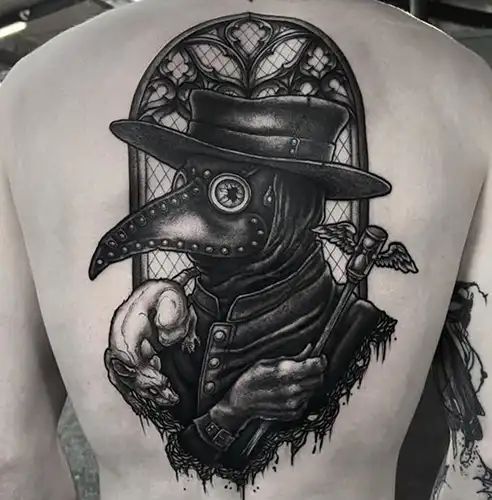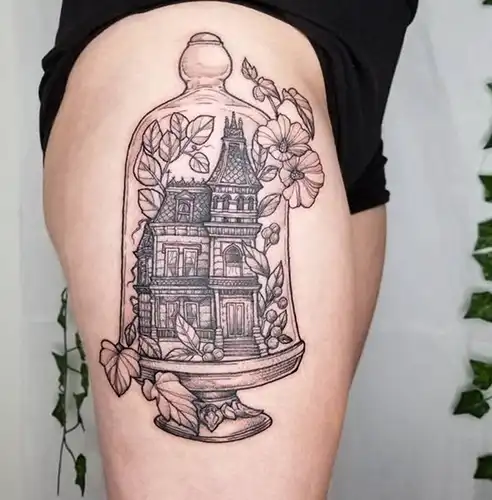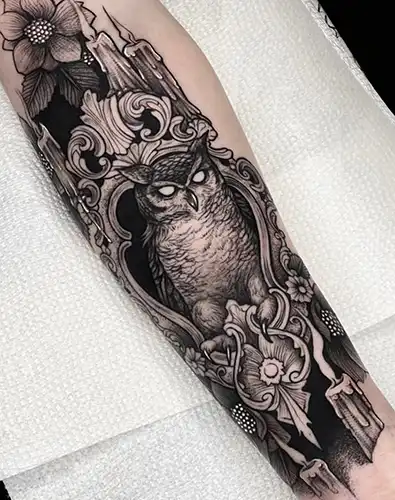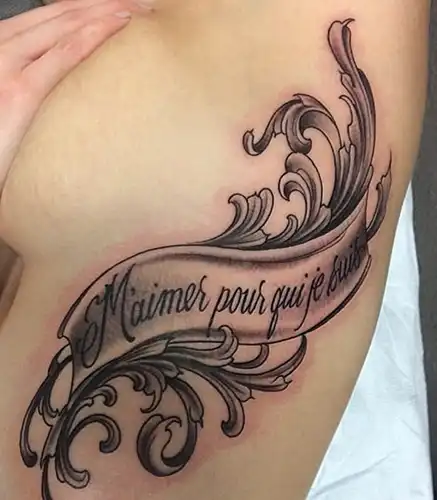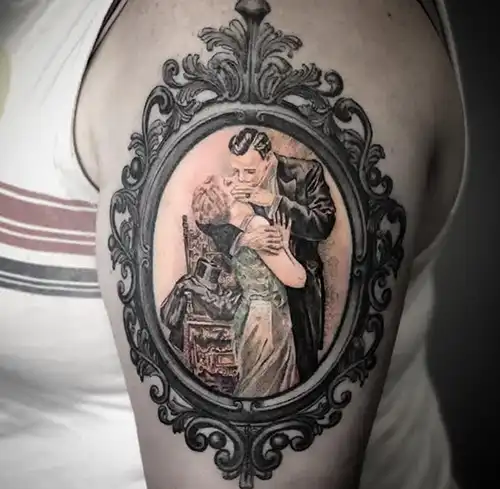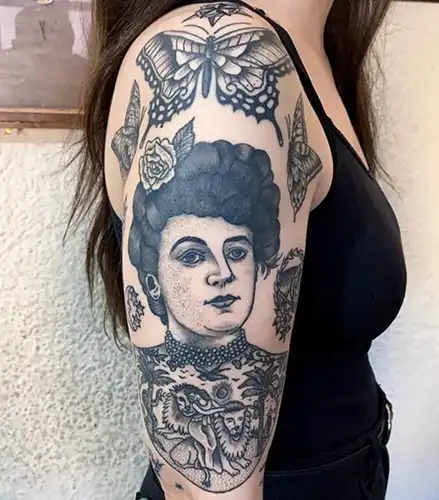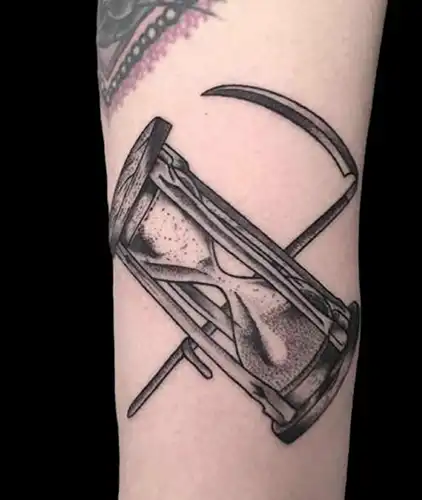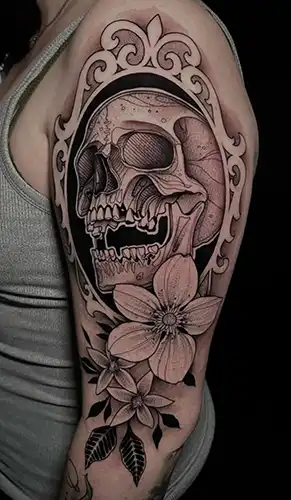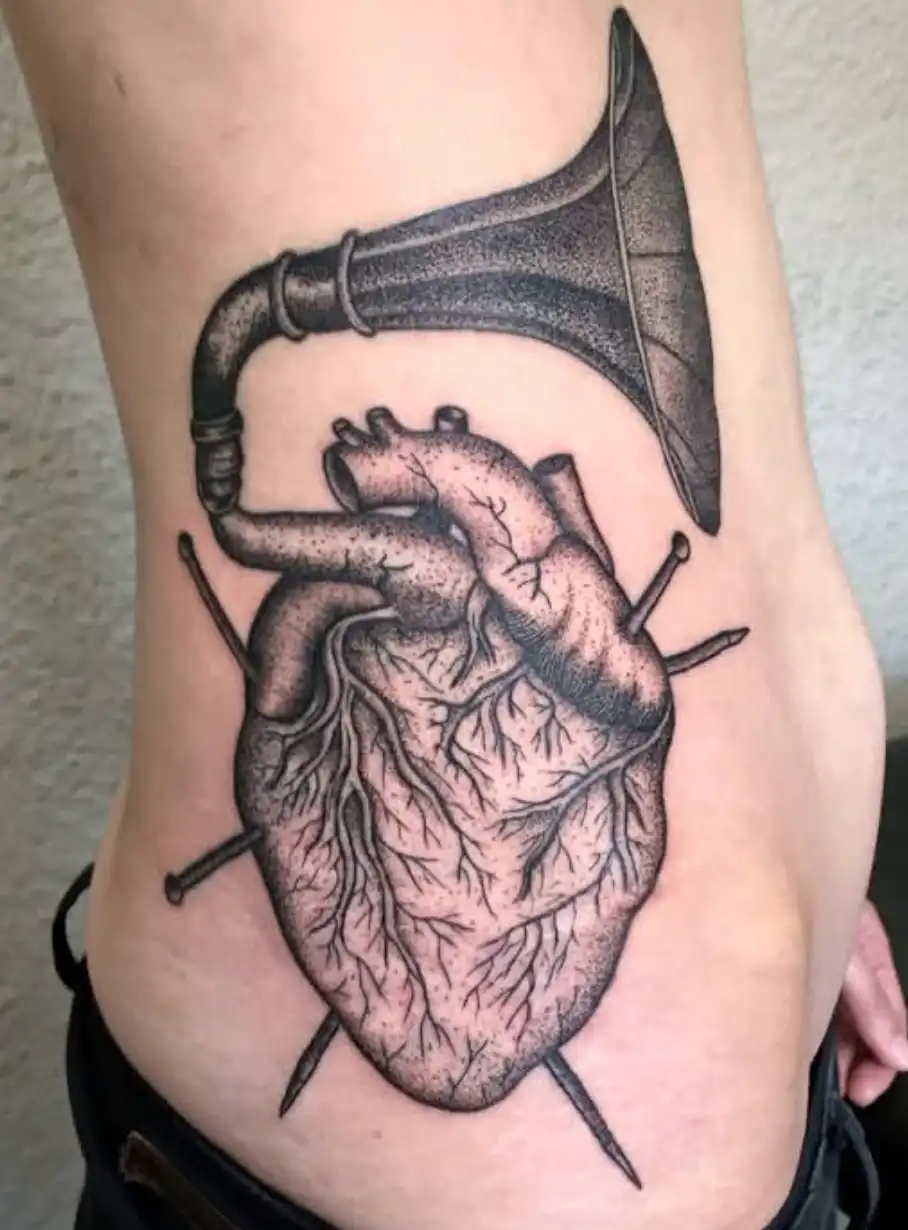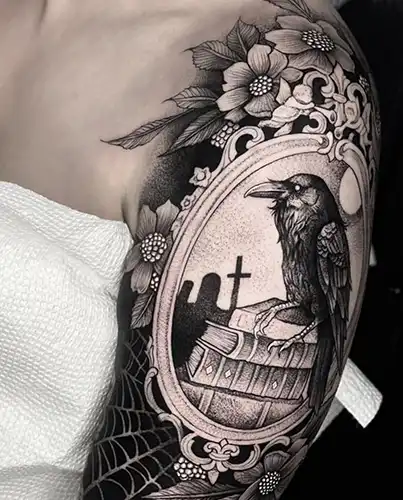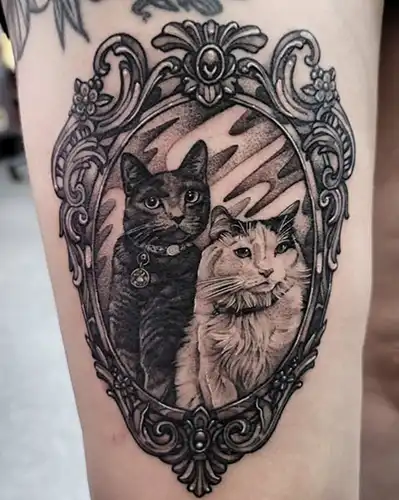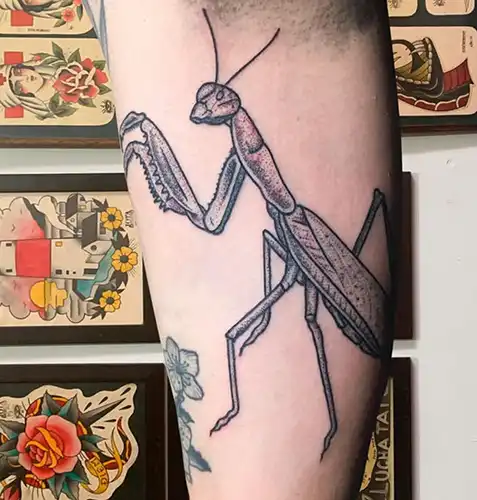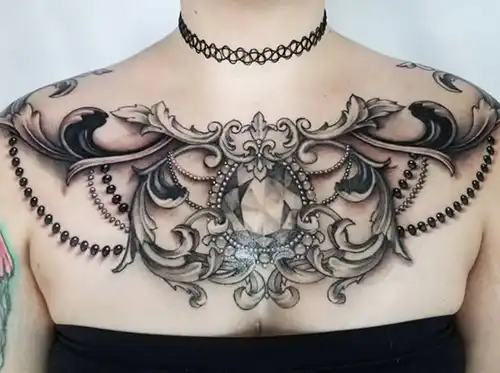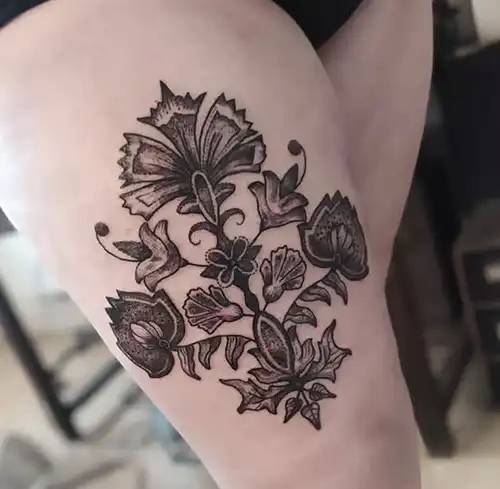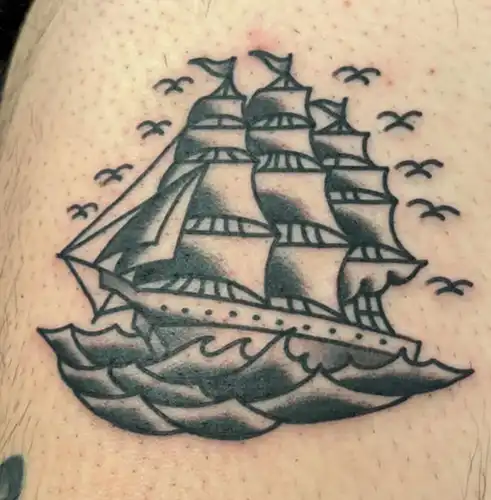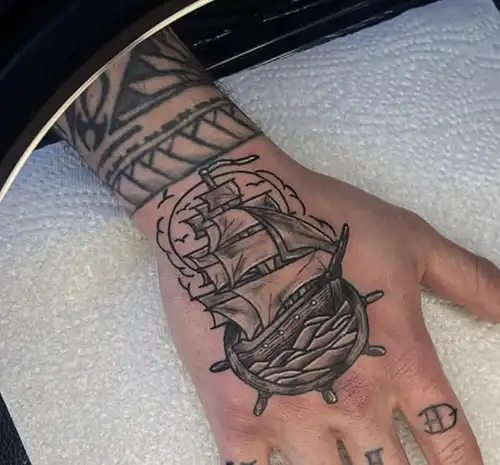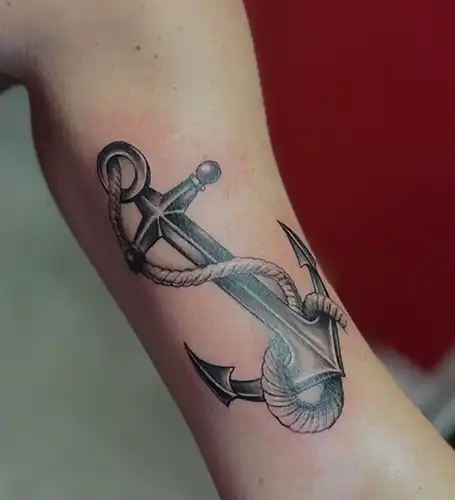Victorian Tattoos in Nairobi, Kenya
Victorian tattoos were an interesting blend of elegance and symbolism, reflecting the aesthetic sensibilities of the Victorian era. During the 19th century, tattoos were primarily worn by sailors and military personnel, but by the late Victorian period, they began to gain popularity among the upper classes as a symbol of status and personal meaning.
Victorian Tattoos
The key features of Victorian Tattoos include:
The key features of Victorian tattoos are deeply rooted in the era’s artistic styles, cultural values, and symbolic language. These elements make Victorian tattoos distinctive and elegant, blending natural beauty with symbolic meaning and Gothic influences. Below are the main features that define this style:
- Floral Motifs
– Roses, lilies, and ivy are common floral symbols in Victorian tattoos, often representing beauty, love, or remembrance.
– Naturalism is highly valued in Victorian art, so these floral designs are often intricate and detailed, reflecting the styles of Victorian embroidery and wallpaper patterns. - Religious and Symbolic Imagery
– Victorian tattoos often included crosses, angels, and cherubs, reflecting the era’s strong religious sentiments.
– Anchor tattoos, while nautical in origin, became a symbol of hope, stability, and faith, which resonated with Victorian sensibilities. - Portraiture
– Some wealthy Victorians commissioned portrait tattoos, often of loved ones or even royalty, as a way to honor and immortalize them.
– These tattoos are usually small and delicate, using fine lines to capture the elegance of Victorian portraiture. - Text and Script
– Victorians were fond of script tattoos featuring phrases, names, or initials in delicate, cursive handwriting.
– Mottos like “Faith, Hope, and Charity” or short poetic lines were common, often accompanied by other symbolic elements like flowers or anchors. - Animal Imagery
– Animals such as swallows, doves, and butterflies are popular, representing themes of freedom, peace, and transformation.
– These tattoos are often quite ornate and could include detailed shading and flourishes. - Victorian Gothic Aesthetic: Tattoos inspired by the Gothic revival featured dark, romantic elements such as skulls, hourglasses, and ravens. These designs played into the era’s fascination with death, mourning, and the supernatural.
Victorian Tattoos Design Style Techniques
Victorian tattoo design style techniques are marked by a fusion of artistic precision, ornate details, and symbolic storytelling, all characteristic of the aesthetic sensibilities of the 19th century. Below are the key techniques and approaches that defined Victorian tattooing:
Fine Linework and Intricate Detailing
Delicate lines are a hallmark of Victorian tattoos, often mimicking the intricate, lace-like patterns found in the textiles, architecture, and jewelry of the time.
Tattoos are crafted with extreme attention to detail and precision, with fine linework creating complex patterns, floral designs, and portraits. This intricate detailing gave Victorian tattoos their elegant and refined appearance.
Ornamental Borders and Frames
Victorian tattoo designs frequently incorporated ornate borders and frames, inspired by the period’s love of opulent decoration. These frames resembled the embellishments found on Victorian mirrors, picture frames, and furniture.
The use of scrollwork, filigree, and floral borders helped to elevate simple tattoos, making even small pieces appear more elaborate and artistic. These decorative borders often encased names, portraits, or meaningful symbols.
Monochromatic Shading
Victorian tattoos largely use black and grey color palette, with minimal use of color. The subtlety of monochromatic shading is employed to create depth, texture, and a sense of realism, especially in designs featuring flowers, animals, or portraits.
Shading is applied in a soft, gradient style, enhancing the 3D effect and giving tattoos a more refined, delicate appearance. This technique is essential for creating dimension in floral motifs and portraits without heavy outlines.
Floral Embellishments
Floral patterns are often used as both the central design and embellishments to accentuate other elements. Common flowers, like roses, lilies, and ivy, are depicted in a highly realistic, detailed manner.
Techniques like hatching and cross-hatching are used to achieve shading in the petals and leaves, creating a natural, three-dimensional effect that mirrored Victorian botanical illustrations.
Victorian Script and Typography
Text is a central component of many Victorian tattoos, rendered in ornate, flowing cursive that mimicked the elaborate handwriting styles of the period. This technique requires precision to ensure that the letters are clear and aesthetically pleasing.
The use of decorative fonts with serifs, flourishes, and embellishments adds a touch of sophistication, often transforming simple text into an artistic element. These scripts are frequently paired with scrolls or banners to give context to the names or phrases.
Portraiture with Realism
Portrait tattoos became increasingly popular during the Victorian era, especially among the upper class. Victorian artists developed techniques to capture realistic likenesses using fine lines, detailed shading, and careful proportions.
These portraits often incorporated intricate hair detailing and subtle facial expressions, lending a sense of depth and personality to the image. Portrait tattoos are frequently framed with ornamental elements or surrounded by floral motifs, enhancing their artistic appeal.
Gothic and Memento Mori Techniques
Gothic-inspired designs, popular during the Victorian Gothic Revival, often featured elements like skulls, hourglasses, ravens, and bats, rendered with dramatic shading and sharp lines to emphasize the dark, haunting themes of life and death.
Memento Mori tattoos used these symbols to remind wearers of mortality. Tattoo artists employed strong contrasts between dark and light areas to enhance the eerie, melancholic atmosphere of these designs. This technique gave tattoos a stark, striking appearance.
Layered Symbolism
Victorian tattoos are often laden with layered symbolism, combining multiple motifs to tell a story or convey personal meaning. For instance, a tattoo might feature a rose (love) intertwined with an anchor (stability), all enclosed in a decorative frame.
Artists use techniques like overlapping elements and blending motifs to create cohesive designs, where each part of the tattoo seamlessly interacted with the others. This layering technique added depth and complexity to the design, allowing for rich symbolic interpretation.
Naturalism and Realism
Victorian tattoo artists took inspiration from the natural world, particularly through the lens of naturalism, which was a popular artistic movement at the time. Techniques for rendering plants, animals, and landscapes were drawn from the botanical illustrations and scientific diagrams of the era.
Nature-inspired tattoos (such as flowers, birds, and insects) were rendered with extreme attention to anatomical accuracy and texture, often using thin lines and gradual shading to mimic the delicate forms found in nature.
Symmetry and Balance
Victorian tattoos often exhibite a strong sense of symmetry and balance, drawing from the period’s emphasis on harmony in design. This can be seen in floral arrangements, animal motifs, and decorative borders, where the elements were carefully placed to create a balanced composition.
Mirroring techniques were used in tattoos to ensure that designs on each side of the body were perfectly symmetrical, particularly in designs that spanned both arms or shoulders. This sense of balance gave the tattoos a more structured and polished look.
Nautical Tattoo Techniques
Nautical tattoos, such as anchors, ships, and stars, employed simple, bold lines combined with subtle shading to give the designs a clean and recognizable look. These motifs were initially popular with sailors and gradually became fashionable in upper-class circles.
The key to these tattoos lay in the bold outlines of the central symbol, often accompanied by additional elements like ropes, waves, or stars, enhancing the nautical theme while maintaining the elegant Victorian style.
Schedule Appointment
Victorian Tattoos FAQs
Victorian Tattoos Process
The process of getting a Victorian tattoo was quite different from modern tattooing, due to the limitations of technology, cultural practices, and artistic techniques of the 19th century. Despite these differences, the core aspects of design, application, and meaning have persisted. Here’s an overview of how the Victorian tattoo process unfolded:
- Concept and Design Selection
– Personal Symbolism and Custom Designs: In the Victorian era, tattoos were often highly personalized. The design process typically starts with a conversation between the client and the tattoo artist about the meaning behind the tattoo. Since tattoos during this time were seen as deeply symbolic, wearers would choose motifs that represented their personal values, beliefs, or memories.
– Influences on Design: Tattoo designs were influenced by Victorian art, literature, and culture, including Gothic and Romantic aesthetics. People selected designs based on themes such as love, faith, loss, mourning, or nature (flowers, birds, animals). Wealthier clients often opted for custom designs, which might include portraits, initials, or elaborate script. - Design Drafting
Hand-Drawn Designs: Unlike today’s digital tools, Victorian tattoo designs were created by hand. The tattoo artist would sketch a draft of the design on paper or directly on the skin, taking inspiration from existing illustrations, such as those found in Victorian botanical books, decorative art, or Gothic revival patterns.
Influence of Fine Art: At Rebel Inks Tattoos Tattoo Removal, and Body Piercings our tattooists are trained as artists, engravers, or lithographers, meaning they have a strong background in drawing and painting. This training is crucial to executing the intricate details seen in Victorian tattoos. - Manual Tattooing Techniques
– Pre-Electric Tools: Before the invention of the electric tattoo machine in 1891, tattoos were applied using hand tools. This process, known as “hand-poking” or “stick and poke”, involved using needles or sharp instruments to pierce the skin and deposit ink. Tattoo artists would dip the needle into ink, then manually puncture the skin to create the desired design.
– Time-Consuming Process: This method was extremely slow and labor-intensive, often requiring multiple sessions for larger or more detailed tattoos. Tattoos with intricate detailing, like those featuring floral designs, portraits, or Gothic symbols, took considerable time to complete.
– Pain and Precision: Since the hand-poking method was more painful and took longer than modern tattooing, it required a great deal of precision from the artist. Victorian tattoos often required great skill to ensure the fine lines and shading were executed properly without modern machines to control the depth and speed of the needle. - Inking Materials
Early Tattoo Inks: The ink used in Victorian tattoos was typically homemade or sourced from natural substances. Artists created their inks using a combination of soot, carbon, ash, plant-based dyes, and sometimes animal-based ingredients. These inks were mixed with liquid binders such as water or alcohol to create a tattooing solution.
– Limited Color Palette: Victorian tattoos were generally monochromatic, often done in black or dark grey shades. Due to the lack of sophisticated color pigments, artists rarely used colored ink. Any color that was used (such as red) was usually limited to a small accent in the design, like a rose petal or heart. - Tattoo Application
– Hand-Poked Tattoos: The process began by applying a stencil or freehand drawing on the skin, often with charcoal or graphite to trace out the design. Then, the artist would use hand-poking tools to prick the skin in small, controlled movements, depositing ink at each puncture.
– Gradual Shading and Detailing: Shading in Victorian tattoos required precision and patience. The artist would go over certain areas multiple times to create a gradient or subtle shadow effect. This process was particularly important in floral designs, animal motifs, or portrait tattoos, where creating dimension was key. - Introduction of the Electric Tattoo Machine (1891)
– The invention of the electric tattoo machine by Samuel O’Reilly in 1891 revolutionized the Victorian tattooing process. The electric machine allowed artists to tattoo faster, with more consistency, and less pain for the client.
– This innovation enabled more complex and larger tattoos to be done in shorter timeframes, which contributed to the growing popularity of tattoos among the Victorian elite.
– The machine also allowed for finer detail and smoother shading, making intricate designs like portraits, floral patterns, and script more accessible and aesthetically pleasing. - Aftercare and Healing
Primitive Aftercare: After getting a tattoo, Victorian clients were instructed to keep the area clean, though aftercare methods were far less advanced than today’s standards. People would often apply salves or ointments made from herbs or animal fats to soothe the skin and prevent infection.
– Healing Time: The healing process took longer due to the manual method of application, and since tattooing tools weren’t always sterile, there was a higher risk of infection or improper healing. - Social Significance and Exposure
– Tattoos as a Status Symbol: In the late Victorian era, tattoos gained popularity among the upper class and aristocracy, becoming a mark of status and individuality. Elite figures, including members of the British royal family, such as Prince Albert and King Edward VII, were known to have tattoos, further legitimizing the practice.
– Exhibition and Secrecy: Despite their growing acceptance, tattoos were often still hidden under clothing, as modesty and decorum were important in Victorian society. However, tattooed individuals, especially those with elaborate designs, became subjects of curiosity in freak shows or tattoo exhibitions, where artists would showcase their work. - Tattoo Artists and Tattooing Culture
– Early Tattooists: Victorian tattooists often worked out of sailor ports, traveling circuses, or private parlors. Some of the more well-known Victorian tattoo artists, such as Sutherland Macdonald (a British tattooist who worked in London), catered to aristocrats and the wealthy, raising the profile of tattooing as a respected craft.
– Tattoo Culture: Although tattoos were growing in popularity among the elite, they still held a connection to sailors, soldiers, and lower-class individuals, who used tattoos as badges of identity, love, or remembrance. - Evolution of Styles: By the late 19th century, tattoo designs became more elaborate, thanks to the use of the electric tattoo machine. Artists could now create larger, more detailed tattoos, and more individuals began embracing the practice as both art and personal expression.
Victorian Tattoos Customization and Personalization
Customization and personalization were key aspects of Victorian tattoos, deeply rooted in the era’s values of individual expression, symbolism, and artistry. Unlike mass-produced or standardized designs, Victorian tattoos were often bespoke creations, tailored to reflect the wearer’s personal stories, beliefs, and experiences. Here’s how customization and personalization manifested in Victorian tattoos:
- Symbolic Representation
– Personal Meaning: Every tattoo design was chosen for its symbolic meaning, often representing aspects of the wearer’s life such as love, loss, faith, or family. For example, a rose could symbolize love or beauty, while an anchor might represent stability and hope. The tattoo was a reflection of the individual’s inner values, beliefs, or milestones.
– Memento Mori: Many Victorians were fascinated by the concept of Memento Mori—the reminder of death’s inevitability. Tattoos featuring skulls, hourglasses, and ravens were highly personalized to remind the wearer of the fleeting nature of life and were often commissioned as a way to reflect personal beliefs about mortality. - Names, Initials, and Dates
– Loved Ones’ Names: It was common for Victorians to include the names of spouses, children, or family members in their tattoo designs, often in elegant script or cursive lettering. This personalization added a sentimental touch, ensuring the tattoo was deeply meaningful to the wearer.
– Commemorative Tattoos: Victorians often commissioned tattoos to commemorate significant life events or the passing of a loved one. This could involve adding dates of birth, death, or marriage, giving the tattoo personal significance and making it a permanent memorial to life’s important moments. - Portrait Tattoos
– Custom Portraits: For wealthier Victorians, tattoo artists created custom portrait tattoos, often of family members, lovers, or even royalty. These tattoos were intricately designed to capture the likeness of the person, ensuring the tattoo was deeply personalized and unique to the individual.
– Framed and Decorative Portraits: Portrait tattoos were often framed with ornamental Victorian-style borders (like filigree or lace-like patterns), making each piece even more personalized by reflecting the design aesthetic of the period. This added an artistic layer of customization. - Floral and Botanical Customization
– Favorite Flowers: Floral designs were extremely popular in Victorian tattoos, and wearers could personalize their tattoos by selecting specific flowers that held special meaning to them. Each flower carried its own symbolism in the Victorian language of flowers (also known as floriography), and clients often chose flowers that represented their personality or personal sentiments.
– Roses could represent love, while lilies were symbols of purity, and ivy could denote loyalty and eternal friendship.
– Custom Botanical Motifs: Some individuals also personalized their tattoos by choosing specific plants or trees that held personal significance, perhaps symbolizing growth, strength, or connection to nature. - Unique Script and Lettering
– Personal Quotes and Phrases: Victorian tattoos frequently featured quotes, mottos, or short phrases that held personal meaning to the wearer. These could be excerpts from literature, religious texts, or even personal mantras. The text was usually written in ornate cursive or Victorian-era calligraphy, further personalizing the design.
– Customization of Lettering: The style of the script was often tailored to reflect the individual’s preferences, whether they wanted something simple and elegant or more ornate, with flourishes and embellishments. - Nautical and Military Personalization
– Sailors and Soldiers: For Victorian sailors, soldiers, and military personnel, tattoos were often highly personalized to reflect their service, achievements, and experiences. Sailors might choose anchors, ships, or stars, while soldiers could incorporate military insignia or national symbols.
– Customized Nautical Themes: Sailors, in particular, customized their tattoos by including specific symbols of their voyages, such as ships or flags, or by adding personalized details like the name of their vessel or locations they had traveled. - Custom Frames and Borders
– Ornate Frames: Victorian tattoo artists were known for adding customized frames and borders to tattoos, using intricate details that reflected the period’s artistic sensibilities. These frames were often inspired by Victorian furniture, picture frames, and jewelry. Each frame could be personalized to complement the central image, whether it was a portrait, floral design, or symbolic motif.
– Personalized Embellishments: Additional scrollwork, lace patterns, or decorative accents could be added to make the tattoo even more unique, giving the tattoo a regal or antique look. - Religious and Spiritual Personalization
– Spiritual Symbols: Religion and spirituality were important in Victorian society, and many individuals opted for personalized religious tattoos. This could include crosses, angels, cherubs, or biblical passages, often designed to reflect the wearer’s personal faith.
– Customized Crosses and Angels: These religious motifs were often highly customized, incorporating ornamental elements like flowers, vines, or scripture to further personalize the tattoo. - Gothic and Dark Imagery Personalization
– Gothic Themes: The Victorian fascination with the Gothic and the macabre led to tattoos that included skulls, ravens, bats, or hourglasses. Each of these dark symbols could be personalized to reflect the wearer’s views on life, death, and the afterlife.
– Custom Dark Imagery: These tattoos were often rendered with dramatic shading and intricate detail, allowing the wearer to customize not only the imagery but also the overall aesthetic and mood of the tattoo, whether they preferred a melancholic or romanticized Gothic style. - Family Crests and Heraldry
– Personalized Family Symbols: Aristocrats and individuals from noble families would often get tattoos that reflected their family crest or coat of arms. These designs were highly personalized, symbolizing the wearer’s lineage, family honor, and social status.
– Customized Heraldry: Tattoo artists would adapt these intricate symbols to tattoo form, incorporating the various shields, animals, and mottos associated with the family crest, making each tattoo unique to the family’s heritage. - Custom Commemorative Tattoos
– Memorial Tattoos: Victorians were known for commemorating deceased loved ones through tattoos. Memorial tattoos often featured names, dates, portraits, or symbols that represented the deceased, such as wreaths, doves, or crosses.
– Remembrance Themes: These tattoos were highly personalized, reflecting the emotional and spiritual connection between the wearer and the loved one being remembered. Some designs would incorporate the person’s favorite flowers or personal belongings. - Combination of Themes and Motifs
– Mixing Personal Themes: One of the most prominent features of Victorian tattoo personalization was the ability to combine different themes and motifs into a cohesive design. For instance, a tattoo could feature a portrait framed with floral patterns, a quote in script beneath it, and small, symbolic elements like hearts or anchors to add further meaning.
– Layering of Symbols: Victorian tattoos were often layered with symbols, allowing the wearer to tell a complex, multi-faceted story. This could involve combining religious, romantic, and commemorative themes, creating a unique and deeply personalized narrative.
Victorian Tattoos Longevity and Aftercare
The longevity and aftercare of Victorian tattoos were crucial factors in ensuring that the artwork retained its clarity and aesthetic appeal over time. However, the methods used during the Victorian era were less advanced than those of today, affecting the tattoo’s durability and requiring specific aftercare practices. Here’s an exploration of how these factors played out during the period:
Tattoo Longevity in the Victorian Era
- Hand-Poked Tattoos vs. Electric Tattoos:
– Before the invention of the electric tattoo machine in 1891, most Victorian tattoos were applied using hand-poking methods, which could lead to less consistency in ink application. Hand-poked tattoos often had a more delicate look, but they could also fade more easily if the ink wasn’t deposited deep enough into the skin.
– The introduction of the electric tattoo machine revolutionized tattooing by allowing ink to be applied more uniformly and at greater speed, improving the longevity of tattoos by ensuring more consistent depth and ink saturation. Tattoos done with the electric machine tended to have clearer lines and longer-lasting shading. - Ink Quality and Composition:
– The inks used during the Victorian era were usually handmade, often derived from natural materials such as carbon, soot, or plant-based dyes. While these inks were functional, their composition was less stable than modern inks, leading to more rapid fading over time. In some cases, tattoos could take on a blueish or greenish tint as they aged, a phenomenon still observed in older tattoos today.
– Since the color range was limited (primarily to blacks and greys), color tattoos were rare, and the longevity of colored tattoos was unpredictable due to the less durable nature of the pigments. - Skin Condition and Sun Exposure:
– Sun exposure and skin aging affected Victorian tattoos much like they do today. Without the benefit of modern sunscreen or other protective measures, tattoos could fade or blur more quickly due to UV damage. Sun exposure caused the ink particles to break down faster, leading to a loss of detail, particularly in tattoos with fine linework.
– The natural aging of the skin also caused tattoos to become less defined over time. As the skin lost elasticity, tattoos could stretch or distort, especially in areas prone to movement, like the hands, arms, and back.
Victorian Tattoo Aftercare
- Basic Cleansing and Healing:
– The Victorian understanding of hygiene and wound care was rudimentary compared to today. Tattoo aftercare typically involved keeping the tattooed area clean by washing it with water and sometimes using herbal ointments or homemade salves to soothe the skin.
– Artists or tattooed individuals might apply natural ingredients like animal fat, beeswax, or lanolin-based balms to the skin to promote healing and protect the tattoo from infection. However, the lack of modern sterilization practices meant that infections were more common, potentially affecting the quality and longevity of the tattoo. - Natural Remedies for Healing:
– Victorian tattoo wearers often turned to natural remedies for aftercare, such as aloe vera, lavender, chamomile, or other plant-based treatments believed to aid in skin healing. These substances were applied to reduce inflammation and keep the skin moisturized, though they lacked the antiseptic properties of modern tattoo ointments.
– Cold compresses might also have been used to reduce swelling in the days following the tattoo session. - Infection Risk and Impact on Longevity:
– One of the major concerns in Victorian tattoo aftercare was the risk of infection. Without proper sterilization methods or knowledge about bacterial contamination, the risk of infection was high. An infected tattoo could result in scarring, loss of ink, or even distortion of the design. Infection often led to poor healing, which significantly impacted the tattoo’s longevity.
– In cases of severe infection, tattoos could become discolored or even partially disappear, especially if the skin healed unevenly or if scar tissue developed. - Moisturizing the Skin: Keeping the tattooed skin moisturized was considered important for helping the skin heal properly. However, Victorian-era moisturizers were typically homemade and could range from plant-based oils (like olive or almond oil) to animal fats. These substances helped prevent the skin from drying out, but they were less effective than today’s specialized ointments in ensuring optimal tattoo healing and ink retention.
- Bandaging and Protection:
– After receiving a tattoo, it was common to cover the tattoo with a cloth or bandage to protect it from dirt and bacteria. The material used would have been simple, such as cotton or linen, which may not have been ideal for wound healing compared to modern, sterile bandages.
– Tattoos were often kept bandaged for several days, and individuals were encouraged to avoid scratching or irritating the area as it healed. The bandaging was necessary to prevent external contaminants from causing infection. - Post-Tattoo Itching and Peeling:
– As the tattooed skin healed, it would typically go through a peeling phase. Itching was common as the tattoo healed, and wearers were cautioned not to scratch the area, as this could damage the ink and cause premature fading or scarring.
– Applying herbal balms or oils was a common way to alleviate itching and keep the skin supple during this phase, though it was important to avoid over-moisturizing the area, which could soften the scabs too early and result in ink loss.
Long-Term Care and Preservation
- Avoiding Over-Exposure to Sunlight:
– Just as today, Victorians were advised to protect their tattoos from the sun to avoid fading. However, since the concept of sunscreen did not exist, people had to rely on clothing or shade to keep their tattoos from being exposed to harsh sunlight.
– Tattooed areas were often covered with long sleeves or high collars, especially since it was considered improper for tattoos to be visible in public. This inadvertent sun protection likely helped preserve the appearance of many tattoos over time. - Regular Maintenance:
– Victorian tattoos could require periodic touch-ups, especially for tattoos done by hand-poking techniques, where the ink might not have been deposited as evenly as with modern machines. Clients often returned to their tattoo artists for additional sessions to ensure that the design stayed sharp and clear.
– Touch-ups were especially necessary for fine linework or intricate designs that might fade faster due to the natural wear and tear of the skin or environmental exposure. - Social and Cultural Norms: Tattoos were often considered private and were kept hidden under clothing. As such, they were less exposed to environmental factors like sun, dirt, or harsh weather conditions, which could have contributed to their relatively longer preservation. However, this also meant that tattoos were often applied in less visible areas, where the skin might be more prone to stretching or sagging, affecting the design over time.
Factors that you should consider when getting Victorian Tattoos
Getting a Victorian-style tattoo is a decision that requires careful thought due to the intricacy, historical significance, and unique design aspects of the style. Below are key factors to consider before getting a Victorian tattoo to ensure the result aligns with your personal aesthetic, the artistry of the era, and practical concerns:
- Design Choice and Symbolism
– Historical Accuracy vs. Modern Interpretation: Decide whether you want a historically accurate Victorian design or a modern interpretation of the style. Victorian tattoos were heavily influenced by symbolism, romanticism, and Gothic elements, so it’s essential to determine if you want to stay true to these themes or adapt them to fit your modern style.
– Personal Meaning: Victorian tattoos often had deep personal significance, with designs like flowers, portraits, anchors, or skulls representing specific values or life events. Consider what the design will symbolize for you—whether it reflects love, loss, faith, or personal milestones.
– Gothic and Romantic Aesthetics: The Victorian era was known for its fascination with Gothic, dark, and romantic motifs. If you’re drawn to the macabre, designs like Memento Mori (reminders of death) or ornamental frames with intricate lacework might appeal to you. If you prefer something lighter, Victorian tattoos also featured floral designs, family crests, and decorative patterns. - Intricate Design and Placement
– Detailed Artwork: Victorian tattoos are known for their fine details, ornamental borders, and intricate shading. Because of the complexity, these tattoos require ample space to fully showcase the design without losing detail. Portraits, lace, floral patterns, or elaborate frames demand a skilled artist who can work with delicate details and ensure that the design remains clear as it ages.
– Placement: The placement of a Victorian tattoo is important because of the intricate design work. Choose an area with enough space to allow for full detailing without crowding the design. Common areas include the back, chest, arms, or thighs, where there’s enough canvas to display the full artistry.
– If you opt for smaller areas like the wrist, ankle, or fingers, consider simplifying the design to avoid blurring or loss of detail over time. - Tattoo Artist Expertise
– Specialization in Victorian Style: Not all tattoo artists are experienced in recreating Victorian-style tattoos. Look for an artist who specializes in fine line work, intricate patterns, and ornate designs. Ask to see a portfolio of similar work to ensure they can replicate the delicate lacework, detailed shading, and historical motifs characteristic of Victorian tattoos.
– Experience with Portraits: If your design involves portraits (a common feature in Victorian tattoos), ensure your tattoo artist has experience with realistic rendering of faces and figures. Victorian portrait tattoos require high precision to capture the subject’s likeness and the decorative framing often used around them. - Color vs. Black-and-Gray
– Traditional Black-and-Gray: Most Victorian tattoos were done in black-and-gray due to the limitations of tattoo inks during that time. This style remains popular today and complements the Gothic, romantic, and ornamental themes of Victorian art. Black-and-gray tattoos also tend to age better, as colors can fade more quickly over time.
– Color Tattoos: If you prefer a modern take on the Victorian style, you can opt for color tattoos. However, colors like red, green, and yellow may not have the same longevity, and intricate designs might lose detail more quickly. Consider discussing with your artist how the colors will age, especially in a design as detailed as a Victorian tattoo. - Tattoo Size and Longevity
– Appropriate Size for Detail: Victorian tattoos often feature small details, so size matters. If the tattoo is too small, you risk losing the intricacy over time as the tattoo heals and ages. Larger tattoos are ideal for preserving the clarity of fine lines, especially in designs with lace-like patterns, text, or portraits.
– Aging and Fading: Victorian tattoos, particularly with intricate lines, may blur or fade over time due to the natural aging of the skin. Choose a size that allows for some margin of error as the tattoo ages. Proper aftercare, such as moisturizing and avoiding sun exposure, will help preserve the design’s longevity. - Personalization
– Custom Elements: While many Victorian tattoos draw inspiration from historical designs, you can still personalize your tattoo to reflect your individual story. You might choose a symbol, quote, or portrait that has special meaning to you, such as a family member or a significant life event.
– Unique Details: Victorian tattoos are all about ornate details, so consider customizing borders, script, or floral elements to make the design your own. Personalization was a hallmark of Victorian tattoos, with people often adding names, dates, or personal mottos to their tattoos. - Skin Tone and Design Contrast
– Contrast and Visibility: Victorian tattoos, especially those in black-and-gray, rely heavily on contrast for their delicate linework and shading. It’s important to consider how the design will look on your specific skin tone. Darker skin tones can still accommodate intricate designs, but it may be necessary to adjust the line thickness or shading techniques to ensure the tattoo remains visible and clear over time.
– Line Thickness: For very intricate designs, the line thickness might need to be slightly adjusted to prevent fading or blurring, especially on skin that tends to absorb ink differently. Discuss with your artist how they can ensure the tattoo’s clarity and longevity, regardless of your skin tone. - Aftercare Commitment
– Initial Healing: Victorian tattoos, due to their detail and shading, require careful aftercare to prevent fading or loss of definition. Follow your artist’s instructions, which may include washing the tattoo with gentle soap, applying moisturizing ointment, and avoiding any tight clothing that may rub against the tattoo.
– Long-Term Care: Victorian tattoos, especially black-and-gray designs, benefit from moisturization and protection from the sun. Regularly applying sunscreen and keeping the tattoo hydrated will help preserve the design’s sharpness and contrast.
– Touch-Ups: Over time, detailed tattoos may require touch-ups to maintain the design’s clarity. Fine lines or complex patterns are particularly susceptible to blurring, so keep in touch with your artist for potential follow-up sessions as the tattoo ages. - Cultural and Personal Considerations
– Social Implications: While tattoos are more socially accepted today, some of the symbolism associated with Victorian tattoos, particularly Gothic, dark, or Memento Mori themes, may still carry a cultural or personal weight. Be mindful of how certain designs may be perceived in your social or professional circles.
– Emotional Significance: Victorian tattoos often had strong emotional and personal ties, so think about the long-term meaning of your chosen design. Ensure the tattoo reflects something significant to you that you’ll feel connected to in the years to come. - Pain and Tattooing Process
– Pain Tolerance: Victorian tattoos, with their intricate detailing and shading, can be more time-consuming to complete, resulting in longer tattoo sessions. Depending on the placement, Victorian tattoos can involve sensitive areas (like the ribs, chest, or back), so consider your pain tolerance and be prepared for a potentially lengthy process.
– Multiple Sessions: Due to the complexity of Victorian-style tattoos, you may need to undergo multiple sessions to complete the entire design. Be prepared for a phased approach if your tattoo involves large areas or detailed work like shading and fine linework.
Cost of Victorian Tattoos in Nairobi, Kenya
The cost of a Victorian-style tattoo can vary greatly depending on several factors, including the tattoo’s size, intricacy, artist expertise, and location. Victorian tattoos are often detailed and require significant time and skill, which can drive up the cost. Here are the key factors that influence the price of a Victorian tattoo:
- Tattoo Size
– Small Tattoos: Smaller Victorian tattoos with limited detail, such as a simple floral design or a basic symbol, may cost between Ksh. 2,000 to Ksh. 5,000. These tattoos are quicker to complete and require less intricate linework, which keeps the price on the lower side.
– Medium Tattoos: For medium-sized Victorian tattoos, like an ornate piece with detailed borders or a portrait, the price can range from Ksh. 5,000 to Ksh. 8,000. This size allows for more elaborate designs and requires more time to execute, especially if shading and fine lines are involved.
– Large Tattoos: Large Victorian-style tattoos, such as full back pieces or full sleeves, can cost anywhere from Ksh. 50,000 to Ksh. 100,000 or more, depending on the level of detail and the number of sessions required. These tattoos involve significant planning and multiple sessions, driving up the overall cost. - Design Complexity
– Ornate Details and Fine Linework: Victorian tattoos often feature delicate lace-like patterns, intricate borders, and complex shading, all of which require more time and skill. The more detailed and intricate the design, the higher the price. Intricate tattoos with lots of linework or detailed portraits can add hundreds to thousands of dollars to the final cost.
– Shading and Layering: Victorian designs often incorporate shading and gradients to create a vintage, timeless look. If your design includes extensive shading or layering, the cost will increase, as shading takes more time and precision than simple linework.
– Custom Designs: If you’re working with your artist to create a fully custom Victorian tattoo, expect to pay more for the time spent on design consultation and sketching. Customization often adds an extra $50 to $200 depending on the complexity of the design process. - Artist Experience
– Highly Skilled Artists: Tattoo artists who specialize in Victorian tattoos or who are known for their expertise in intricate designs, portraits, or fine linework often charge premium rates. For top-tier artists with a strong reputation, rates can range from Ksh. 5,000 to Ksh. 50,000, depending on their experience and demand. At Rebel Inks Tattoos, Tattoo Removal, and Body Piercings Parlour we have a team of experinced and seasoned artists.
– Location-Based Pricing: In major cities tattoo artists generally charge more due to higher demand and living costs. In smaller towns or regions with fewer tattoo studios, prices might be lower, but it’s essential to ensure the artist has the right expertise for a Victorian design. Rebel Inks Tattoos, Tattoo Removal, and Body Piercings Parlour is located in the heart of the Central Business Disrict (CBD) in Nairobi, Kenya, and is easily accessible to both locals and foreigners in the country - Session Length and Time Required
– Simple Victorian designs may take 2-4 hours, while large, intricate pieces could take 10-20 hours or more spread across multiple sessions.
– Multiple Sessions: For larger tattoos or more detailed work, you’ll likely need to schedule multiple sessions. Each session typically lasts between 2 to 6 hours, and you’ll be billed for each session based on our artist’s rate. Expect to spread the cost over time if you’re getting a large piece that requires several appointments to complete. - Color vs. Black-and-Gray
– Black-and-Gray: Victorian tattoos are traditionally done in black-and-gray, which is often less expensive than color tattoos. Black-and-gray tattoos are typically quicker to apply and have a more classic Victorian feel. This style tends to fall on the lower end of the pricing spectrum if the design is simple.
– Color Tattoos: If you opt for a color Victorian tattoo, the price can increase because color tattoos require more shading, blending, and often more sessions to achieve the desired effect. Colors also tend to require touch-ups over time, which could add to the overall cost of maintaining the tattoo. - Customization and Design Time
– Consultation Fees: At Rebel Inks Tattoos, Tattoo Removal, and Body Piercings Parlour we might charge for consultation time, which can otherwise be deducted from final price, especially if you’re commissioning a custom Victorian design. Consultations can range from Ksh 1,000 to Ksh 3,000 or more, depending on our artist’ rate and the complexity of the design work.
– Complex Design Process: Victorian tattoos often involve a detailed consultation to get the artwork just right. If you require multiple design iterations or a highly detailed custom piece, the design fees could add significantly to the total cost. - Touch-Ups and Maintenance
– Touch-Up Policies: Victorian tattoos, especially ones with fine details, may need touch-ups over time to keep the design crisp and vibrant. At Rebel Inks Tattoos, Tattoo Removal, and Body Piercings Parlour our tattoo artists offer a discounted touch-up session within the first year of getting the tattoo. After that period, you may need to pay for touch-ups, which can range from Ksh. 2,000 to Ksh. 10,000 depending on the extent of the work.
– Long-Term Costs: To maintain a detailed Victorian tattoo, especially if it’s in color, expect occasional touch-ups every few years to ensure the design doesn’t fade or blur. These costs should be factored into the overall lifetime investment of the tattoo.
Get In Touch
For more information on the list above and any other special services,please call or come in for free consultation
Testimonials
After he pierced my industrial piercing and seeing his amazing work, I feel even more excited about getting my tattoo with him in January. I’m really looking forward to it!
I am extremely happy with my new 'Safari' tattoo from Eric at Rebel Inks! The quality of the artwork is fantastic. Eric is a true professional and an amazing artist.
The preparation and design process was thorough and collaborative. He was very patient with my specific requests, including making sure all the elements, which hold personal meaning, were perfect.
The service was friendly and highly professional from start to finish. Despite the 8-hour session, Eric was a pleasant person to spend the time with.
The aftercare guidance and follow-up have been excellent and careful, which has made the healing process easy and better than expected.
I highly recommend Eric for anyone looking for a thoughtful, talented, and caring tattoo artist.
I recommend them 💯
I would definitely recommend if you’re thinking of getting a piercing!
The staff were super friendly, explained everything clearly, and made me feel so at ease. They answered all my nervous questions (and I had many questions),
They walked me through the whole process, gave detailed aftercare instructions, and even followed up afterward to check how I was healing 🫶
Clean, professional, and full of good vibes.
Would 100% recommend . Definitely making a second trip here.
This was the second tattoo I got and I wish I could have come to Eric for my first one! He gave me really great after-care directions for the tattoo as well as a little jar of his own Vaseline-type stuff to put over my tattoo while it was healing! He even put second skin over my tattoo so that I didn’t have to worry about it for the first few days. Now THAT’S good service. My first tattoo artist didn’t do none of that lol.
After the session Eric didn’t rush me and my friend out, he chatted with us and even when he found out I was an artist too— really encouraged me to keep creating and to find a community of artists to support me. I almost cried because I’ve had such a hard time with my own art the past couple of years, it meant so much to me to have a fellow very talented artist say that to me. 🤍🤍🤍
Eric you’re amazing, don’t ever stop creating and just know you’ve impacted lives all over the world!🫶🏻 thanks so much for everything!!
From the moment I walked in, Eric was professional, welcoming, and attentive. He made sure I was comfortable throughout, provided everything I needed, and explained every step of the process. The tattooing itself was unbelievably smooth - I genuinely felt no pain compared to my previous tattoos over the last 22 years.
Eric also gave me excellent aftercare guidance and products, and thanks to that, my tattoo healed beautifully. The attention to detail, precision, and shading are absolutely stunning. This is hands-down the best tattoo I've ever had, and I will be flying back to Nairobi for any future ink.
If you want incredible art, a professional experience, and a talented artist who truly cares about his clients, Rebel Ink is the place to go!
From start to finish, the service was exceptional. The piercer was professional, knowledgeable, and made me feel completely comfortable. The cleanliness of the place was above and beyond — everything was spotless and hygienic, which really put me at ease. Highly recommend for anyone considering a piercing!
Shout out to Eric😘
We ended up changing the jewelry three times to ensure I had the best fit and avoided any signs of rejection, and he always listened to my suggestions as a client, which I really appreciated. Now, three months in, my piercing is healing beautifully, with no sign of rejection. Highly recommend for anyone who values a piercer who cares about your comfort and healing journey!
What stood out the most was the aftercare Eric checked in with me even three weeks later to see how the tattoo was healing. That kind of follow-up shows how much he truly cares about his work and his clients.
I’m very satisfied and will definitely be coming back for my next piece. Highly recommend!
The piercing wasn't as painful as I had thought and the process was quick and satisfactory. I love it!!!
The piercing is healing well thanks to the aftercare instructions and follow-up. I would highly recommend Rebel Inks
Eric also did a belly button piercing for a friend, guiding her through the process, doing the piercing and then explaining the after care to her.
The shop is on the 3rd floor, with the entrance to the stairs near an alleyway on the left. The shop is perfect size, clean, and attractive looking. The mural is pretty dope.
Thank you for the amazing service! 🔥👅✨
I got piercibgs there and the process was really good. My biggest concern was hygiene but that wasn't an issue at all, they use new needles and they sanitize them.
The service itself was also welcoming.
I was informes of everything i needed to know beforehand.
10/10 would recommend!
Eric was so calm and patient with my almost 2 year old lady. It was such a clean and hygienic process. We will definitely be back for our second rounds of piercings and maybe even another tattoo!
They assess the area before any art and advise one accordingly. They also give one post clean up process and also do a check up after the body art projects. Overall, I loved my experience and I’m hooked. 👍
Will definitely come back next time I’m in town 🙂
He listened to what I actually wanted and made sure he could fit in the time before I flew back home.
The shop is clean & private and is easy enough to find.
Eric has even checked in a couple of times since to make sure all is good.
I would totally recommend Eric! I absolutely love my Elephants!
I had a very easy healing period and always follow up from Eric to check on my progress...I would highly recommend if you are a first timer because from my experience all went very well and attention to detail
Thank you for a good job and looking forward to send all my friends your way
And all the best with the new year 2025!
From the moment I walked in, the staff was super friendly and made me feel at ease. The studio had a clean, professional atmosphere, which immediately put me at ease. My piercer was incredibly skilled and explained every step of the process, ensuring I was comfortable the entire time. The piercing was quick and practically painless, and the aftercare instructions were clear and easy to follow. I can tell they really care about the health and safety of their clients.
Overall, a fantastic experience—I highly recommend Rebel Inks and Tattoos for anyone looking to get pierced or tattooed!
They do follow up after their services
Eric's Studio isn’t just a place to get a tattoo—it’s an experience. The combination of professionalism, artistic talent, and a welcoming environment makes it a standout destination for anyone considering a tattoo.
I highly recommend Eric’s Studio to both first-timers and seasoned tattoo enthusiasts. If you’re looking for a high-quality tattoo and an enjoyable experience, this is the place to go.
I would definitely recommend their services again and again
Thank you Rebel Ink
My piercings are healing ❤️🩹 well
I would 💯 recommend
I will definitely come back for more .
Two, all the equipments he used for the piercings were new and/or sterilised.
Three, the parlour itself was very clean and was up to par with the hygiene standards.
Four, Eric provided effective aftercare instructions, making sure I knew exactly how to take care of my new piercings and he kept in touch and continues to do so, to check on the healing progress.
I highly highly highly recommend this place!!!
Would definitely recommend them to friends and go back for other piercings
Not only was the piercing process smooth, but he also provided thorough aftercare instructions, making sure I knew exactly how to take care of my new piercings. What really impressed me was that he keeps in touch to check on how the healing is progressing – a sign of true care for his clients.
The shop maintains a high standard of hygiene, and the atmosphere is welcoming and comfortable, which really added to the positive experience. I highly recommend this place to anyone looking for a professional and caring experience. I’ll definitely be coming back for any future piercings!
My appreciation for the excellent customer service I received. The follow-ups were prompt, and I truly appreciated the gentleness and professionalism throughout. Thank you!"
"Looking for professional eyebrow microshading removal? Look no further!"
The customer care is top tier 👌🏾👌🏾.
Wonderful place to get tattoos and piercings. 💯💯
Eric goes ahead to follow up on his clients progress and gives good advice each time I reach out to him.
I would recommend Reble tattoos anytime.
Good job bro we really appreciate.
Ohh and the price is very fair.
The environment was clean , procedure was sterile and the jewelry used are of the best quality.
He followed up with me during the healing process, he educated me on what I needed to do for my aftercare.
Eric is confident, skilled , experienced and the best piercer. Highly recommend Rebel inks.✨
Definitely recommend!
Great experience.
Eric definitely know what he is doing .
I got exactly what I wanted 2 tiny tats on the same finger .
He was kind and patient throughout the session.
Healing process has been good .
Aftercare services were given and regular checkups on the healing process were done.
I would 💯recommend.
Eric gave me the best reception as it was my first time there,and made me trust him all the way. I appreciate good services.
There services are also affordable not to forget 😊.
He was also invested in the aftercare and would ensure I follow the do's and don'ts in taking care of the tattoo and ensuring proper healing and maximum ink retention.
Would highly recommend Rebel Inks Tattoos.
Rebel Inks Tattoo offer the best,affordable and quality tattoo removal services.If you have unwanted ink,choose Rebel Inks Tattoo,they're the best of the best and the professionalism is a top notch.They ensure you're free from unwanted ink with their Laser Tattoo Removal Technology...
I did a Laser Tattoo Removal with them and i can attest they're the best....
Kudos Eric...
I highly recommend.
It was a generally good experience with good hygiene during the piercing process and has been a smooth healing process.... 10/10
tips. Highly recommend 👍🏽
100% recommendable.
I was particularly impressed with Eric's attention to hygiene. He thoroughly cleaned the room before I entered, sanitized all of the equipment he would be using, and changed gloves between each ear. This level of cleanliness gave me great confidence in his professionalism.
Eric's commitment to customer service did not end on the day of the piercing. He followed up with me regularly throughout the healing process to ensure that I was following the aftercare instructions and that my earlobes were healing properly.
I highly recommend Rebel Inks to anyone in Nairobi who is considering getting a piercing. Eric is a highly skilled and experienced piercer who takes great pride in his work.
So I Check all the boxes below and more:
Customer Care: ✔️
Professionalism : ✔️
Cleanliness ✔️
Price: ✔️
After care service ✔️
Thanks and good job, Eric
The place is neat and clean and the equipments he used were also fine standards. Really appreciate his following up with me on the healing 🤗
I WOULD HIGHLY RECOMMEND THEIR SERVICES to everyone. Actually what you see on their website is EXACTLY what you will get. Keep up the good work Rebel inks Tattoos.
The infection is now gone. I would definitely recommend!
Can recommend this place totally and would go back there anytime!
Thanks!
OUR LOCATION
Areas We Serve
NAIROBI
KIAMBU
KAJIADO
MACHAKOS


